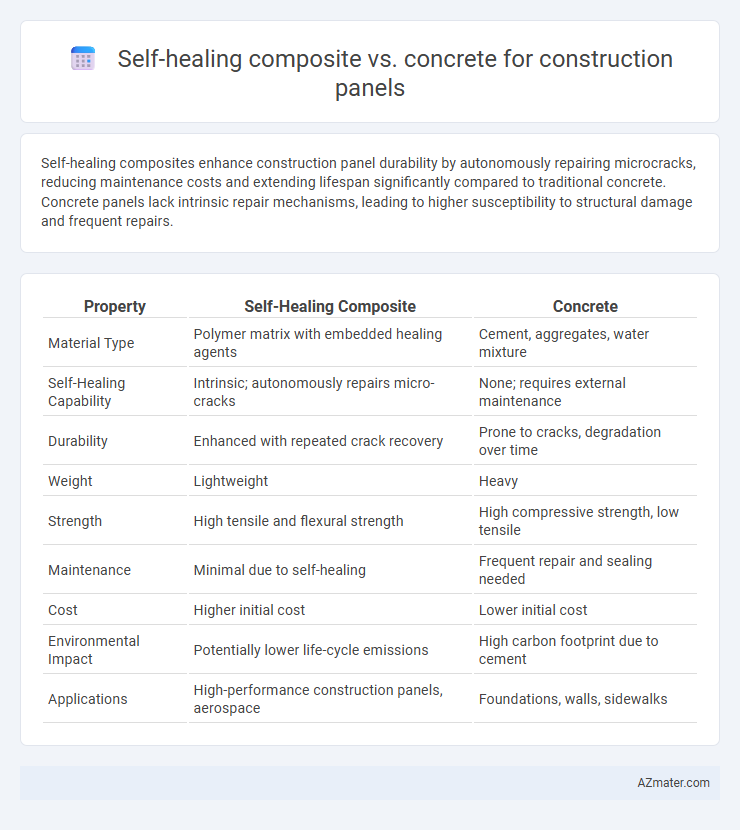Self-healing composites enhance construction panel durability by autonomously repairing microcracks, reducing maintenance costs and extending lifespan significantly compared to traditional concrete. Concrete panels lack intrinsic repair mechanisms, leading to higher susceptibility to structural damage and frequent repairs.
Table of Comparison
| Property | Self-Healing Composite | Concrete |
|---|---|---|
| Material Type | Polymer matrix with embedded healing agents | Cement, aggregates, water mixture |
| Self-Healing Capability | Intrinsic; autonomously repairs micro-cracks | None; requires external maintenance |
| Durability | Enhanced with repeated crack recovery | Prone to cracks, degradation over time |
| Weight | Lightweight | Heavy |
| Strength | High tensile and flexural strength | High compressive strength, low tensile |
| Maintenance | Minimal due to self-healing | Frequent repair and sealing needed |
| Cost | Higher initial cost | Lower initial cost |
| Environmental Impact | Potentially lower life-cycle emissions | High carbon footprint due to cement |
| Applications | High-performance construction panels, aerospace | Foundations, walls, sidewalks |
Introduction to Self-Healing Composites and Concrete Panels
Self-healing composites incorporate advanced materials with embedded microcapsules or vascular networks that autonomously repair micro-cracks, enhancing durability and longevity in construction panels. Concrete panels, traditionally used for structural and architectural applications, often suffer from micro-cracking that compromises integrity and requires manual maintenance. The integration of self-healing technology in composites offers a revolutionary alternative by reducing maintenance costs and extending service life through intrinsic healing capabilities.
Material Composition and Structure
Self-healing composites for construction panels incorporate microcapsules or vascular networks filled with healing agents embedded within polymer or fiber-reinforced matrices, enabling autonomous crack repair and enhanced durability. Concrete panels primarily consist of cement, aggregates, water, and sometimes supplementary materials like fly ash or slag, forming a rigid, brittle matrix that lacks intrinsic self-repair capabilities. The composite's adaptive material structure contrasts with concrete's heterogeneous, porous framework, offering superior resistance to microcracking and longevity in infrastructure applications.
Mechanisms of Self-Healing in Composites
Self-healing composites utilize embedded microcapsules, hollow fibers, or vascular networks filled with healing agents such as polymers or adhesives that activate upon damage, effectively sealing cracks and restoring mechanical integrity. Unlike concrete, which relies primarily on autogenous healing through hydration of unreacted cement particles and secondary calcium carbonate precipitation, composites enable targeted and repeated healing cycles due to their engineered architectures. These mechanisms improve durability and reduce maintenance costs in construction panels by minimizing crack propagation and enhancing structural resilience.
Durability and Longevity Comparison
Self-healing composites exhibit superior durability compared to traditional concrete by autonomously repairing micro-cracks, reducing maintenance needs and extending service life. Concrete panels are prone to crack propagation and degradation over time, leading to costly repairs and shorter longevity. The advanced self-healing mechanisms in composites enhance structural integrity and significantly improve lifespan in construction applications.
Structural Performance under Load
Self-healing composites exhibit superior structural performance under load compared to traditional concrete due to their ability to autonomously repair microcracks, maintaining integrity and extending service life. These materials enhance load-bearing capacity and reduce the risk of catastrophic failure by restoring stiffness and strength after damage. In contrast, concrete panels typically require manual repair and often experience diminished durability and increased maintenance costs when subjected to repeated or sustained loads.
Environmental Impact and Sustainability
Self-healing composites significantly reduce environmental impact by extending the lifespan of construction panels and minimizing material waste through autonomous crack repair, unlike traditional concrete which often requires frequent maintenance and replacement. These advanced materials lower carbon footprint by decreasing the need for energy-intensive production and reducing CO2 emissions associated with conventional cement manufacturing. Sustainable construction benefits from self-healing composites through enhanced durability, resource efficiency, and reduced landfill waste, positioning them as a greener alternative to standard concrete panels.
Cost Analysis and Economic Considerations
Self-healing composites for construction panels significantly reduce long-term maintenance costs by autonomously repairing micro-cracks and extending service life, compared to traditional concrete which incurs frequent repair expenses. Initial investment in self-healing materials is higher, but life-cycle cost analysis reveals superior economic efficiency through reduced downtime and fewer interventions. Economic considerations also favor self-healing composites in sustainability-focused projects, where minimized resource consumption and enhanced durability translate into greater overall savings.
Ease of Installation and Maintenance
Self-healing composites significantly reduce maintenance efforts compared to concrete panels by autonomously repairing micro-cracks, minimizing downtime and repair costs. These composites are lighter and more manageable during installation, allowing for faster construction and reduced labor requirements. In contrast, concrete panels often require specialized equipment for handling and frequent manual inspections to address cracks and structural damage.
Applications in Modern Construction
Self-healing composites offer advanced durability and crack-resistance in construction panels, improving longevity compared to traditional concrete. These materials enable rapid automatic repair of micro-damages, reducing maintenance costs and increasing structural integrity in modern architectural designs and infrastructure projects. Utilized in facades, bridge decks, and high-stress load-bearing panels, self-healing composites enhance resilience against environmental stressors and mechanical fatigue.
Future Prospects and Innovations
Self-healing composites exhibit superior durability and reduced maintenance costs compared to traditional concrete panels, making them highly promising for future construction applications. Innovations in microcapsule technology and embedded healing agents enhance their ability to autonomously repair cracks, extending the lifespan of structural elements. These advancements suggest a significant shift towards sustainable building materials that optimize structural integrity and lifecycle performance in modern construction projects.

Infographic: Self-healing composite vs Concrete for Construction panel
 azmater.com
azmater.com